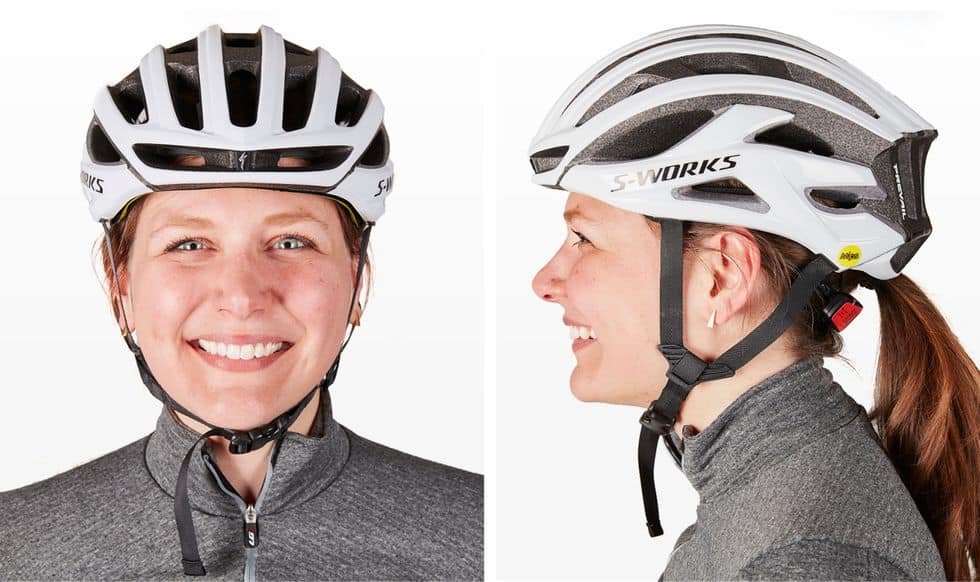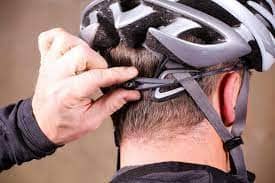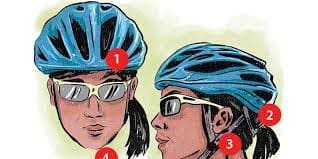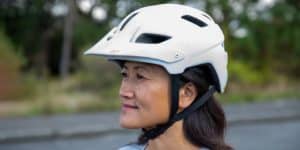
Bicycling is a great way to get exercise, and it’s also a fun hobby. However, one thing that can ruin the experience is a bike helmet that doesn’t fit properly.
A bike helmet is an essential piece of safety gear for cyclists. It can help protect you from severe injuries in a crash.
However, if a helmet doesn’t fit properly, it won’t do its job very well. This blog post will discuss making sure your bike helmet fits correctly.
We’ll also provide tips for ensuring your helmet stays in good condition. So, let’s discuss in detail how a bike helmet should fit!
How to choose the right size bike helmet?

There is no one-size-fits-all answer to this question, as the right size bike helmet will depend on several factors, including your head circumference and the type of bike riding you do. However, you can follow some general guidelines when choosing a bike helmet, which we’ve outlined below.
To start, measure your head circumference using a soft tape measure. Place the tape measure around your head, just above your eyebrows. Make sure the tape measure is level around your head, and note down the measurement in inches or centimeters.
Once you have your head circumference measurement, consult a bike helmet size chart to determine which size helmet is best for you. Remember, the size of your bike helmet should match the size of your head, so make sure to choose a size that’s not too large or too small.
There are three main types of bike riding – road biking, mountain biking, and BMX riding. Different kinds of riding require different helmets, so make sure you choose one designed for the riding you do most often. Many helmets are available with a rubber band to tighten the chin strap.
How to wear a bike helmet correctly?

Most people know that it is important to wear a bike helmet when riding. However, many do not know how to wear one correctly. Here is a detailed guide on how to wear a bike helmet correctly.
- The first step is to find a bike helmet that fits properly. It should sit snugly on your head and should not be able to move around too much. You can test the fit by trying to push the helmet up or down with your hands. If it moves more than an inch, it is too loose and needs to be tightened
- Once you have found a helmet that fits properly, the next step is to adjust the straps to be tight enough but not too tight. The straps should sit just below your ears. You can test the tightness of the straps by trying to pull the helmet off with your hands. If it comes off easily, the straps are too loose and need to be tightened.
- The last step is to adjust the chin strap to be snug but not too tight. The chin strap should sit just below your chin. You can test the tightness of the chin strap by trying to pull the helmet off with your hands. If it comes off easily, then the chin strap is too loose and needs to be tightened
By following these simple steps, you can ensure that you are wearing your bike helmet correctly. This will help protect you in case of an accident.
How not to wear a helmet

Not wearing a helmet while riding a bike is illegal in many states, but it is also hazardous. Wearing a helmet can help protect the head and reduce the risk of serious injury in a fall or collision. Additionally, it is essential to ensure that the helmet fits properly and is positioned correctly on the head to provide optimal protection.
Additionally, not wearing a helmet increases the risk of death in the event of a crash or collision. It is important always to wear a helmet when riding a bike and make sure that the helmet fits properly and is positioned correctly on the head,
How do I know if my bike helmet is too small?

A bike helmet that is too small will not provide adequate protection in a crash or collision. Additionally, a helmet that is too small will be uncomfortable to wear. To determine if a helmet is too small, measure the head circumference and consult a size chart.
If the head circumference is larger than the largest size on the chart, then the helmet is too small. Additionally, if the helmet does not fit snugly on the head or does not sit level on the head, it is likely too small.
How do you know if a helmet fits properly?

A good fitting helmet should be snug but not too tight. To check if the helmet is too small, try to move it back and forth and up and down.
If the helmet does not budge, then it is too small. Additionally, the straps should be tightened or loosened to ensure a comfortable, snug fit.
Should your size be up or down in a bike helmet?

Does the strap comfortably snug correctly? It is important to find a bike helmet that fits snugly and comfortably on the head. To do this, first, measure the circumference of your head with a tape measure. Next, use the measurement to find a helmet with the correct size.
Once you have found the right-sized helmet, adjust the straps to ensure a snug, comfortable fit. Additionally, make sure that the helmet is positioned correctly and covers the forehead. Finally, adjust the helmet so that it sits level on the head.
Should a helmet fit tight or loose?

A well-fitting bicycle helmet should be snug but not too tight. To check if the helmet is too small, try to move it back and forth and up and down.
If the helmet does not budge, then it is too small. Additionally, the straps should be tightened or loosened to ensure a comfortable, snug fit. It is too big if the helmet moves around on the head or feels loose.
What happens if you don’t wear the helmet correctly?

Make sure that your helmet sits properly on your head. If you do not wear the helmet correctly, it will not provide adequate protection in the event of a crash or collision. Additionally, not wearing a helmet increases the risk of serious injuries, including traumatic brain injury, skull fractures, and concussion.
Finally, not wearing a helmet also increases the risk of death in the event of a crash or collision.
It is important to always wear a helmet when riding a bike and make sure that the helmet fits properly and is positioned correctly on the head. Therefore, a correct-fit helmet with side straps and front edge covered will fit comfortably to absorb even violent shakes.
You may also like: Best Bike Helmets for Children
Tips for wearing bike helmet properly
Some tips for wearing bike helmets properly include:
Make sure that the helmet fits snugly on the head.
Position the helmet to sit level on the head and cover the forehead.
Adjust the straps so that they are tight enough to keep the helmet in place but not so tight that they are uncomfortable.
Do not wear a helmet on your head that is too loose or too tight.
Do not wear a helmet that is not positioned correctly on the head.
Do not wear a helmet that does not have the straps adjusted properly. The helmet should cover the front rim and ear lobes.
The strap edge should be one inch or two fingers, so the helmet should sit level with your head.
You may also like: Low Profile Bike Helmets
stayontrails
Latest posts by stayontrails (see all)
- How To Bike Uphill Without Getting Tired - May 12, 2022